|
INLAND
From Juptner's volume 3, page 171 (left sidebar)
we learn at Inland that, "The original prototype airplane
that was later developed into the Inland 'Sport', was a 1927
design by 'Dewey' Bonebrake [sic]; this was a light 2-seated
'parasol' monoplane of typical configuration that was reported
to be powered with a 6 cyl. Anzani (French) engine."
The third
image, below, from Mr. Lance Borden (right sidebar) corroborates
the engine brand that was installed on the prototype, but
the number of cylinders was three, not six. Mr. Borden is
the grandson of Lawrence Dewey Bonbrake (note the correct
spelling).
Juptner
continues, "The prototype airplane by Bonebrake [sic] was
flown by Gene Gabbart (or Gebhart) [it is Kenneth Eugene Gabbert] to the
1928 National Air Races held in Los Angeles; it was planned
to show it off and perhaps secure a sponsor for its manufacture.
... Arthur Hardgrave, who was later impressed with its character
and its possibilities, decided to sponsor the new design
for manufacture and the Inland Aviation Co. was formed at
Kansas City, Mo. for that purpose. ... L.D. Bonebrake [sic],
originator of the design that led to the Inland 'Sport',
was an engineer and test pilot for Unit Motors & Airplane
Co. of Kansas City, Mo. in 1924..." Compare this information
from Juptner with the actual landing of the prototype at
Tucson as described below in the section INLAND
AIRCRAFT OF THE REGISTER.
Juptner (Volume 4, page 146) concludes the
Inland story thusly, "Fighting gamely to beat the odds imposed
by a nation-wide business depression, the Inland Aviation
Co. held on as best they could, but by late 1931 or 1932
they had to withdraw to the circle of bankrupt airplane companies.
They soon became just another memory spawned in that wonderful
hey-day of the 'twenties'."
THE DESIGNER OF THE MARQUE
Lawrence Dewey Bonbrake, with his Curtiss JN-4
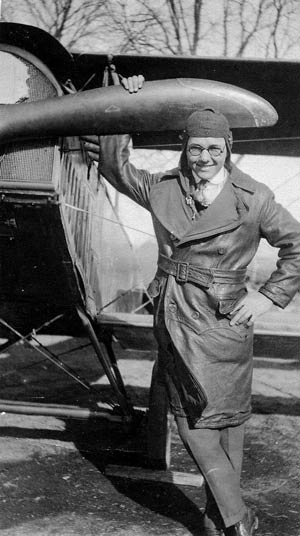 |
People who contact me through my site are treasures of information
regarding our pilots, passengers and airplanes from our Davis-Monthan
Register. For this page, the grandson of the designer of
the Inland airplane provides primary background (CREDITS,
right sidebar).
Mr. Borden states in an email to me, " My maternal
grandfather, Lawrence Dewey Bonbrake, designed the Inland
Sport in Kansas City in about 1927-28. The first production
model was announced in September 1929. Inland made about
46 airplanes before going bankrupt in 1931 because of the
Great Depression."
Further, "Here is a photo [left] of my grandfather,
Lawrence Dewey Bonbrake, with his Curtiss JN-4 'Jenny' he
called 'Little Oscar' in 1920."
Please follow this link to see an aerial image of the Inland plant ca. 1930 (image exhibited below). It's a good idea to browse around that link, too, as there are images of Inland aircraft and pilots available. All images are black & white.
Mr. Borden says of the image, below, "Here is another
photo of him after a hard day's work testing the Inland Sport
prototype." In the original photo, and to a certain extent
on this web-optimized copy, you can see scars on Mr. Bonbrake's chin,
lower lip, cheek and nose.
Lawrence Dewey Bonbrake, ca. 1925
 |
Mr. Borden says of the scars, "My grandfather
got that scar and the ones on his nose and upper lip that
are harder to see from crashing in his Jenny. He was barnstorming
and had the stick removed from the front cockpit where the
passengers usually rode. I don't know the details fully,
but somehow a guy convinced him that he was a pilot and wanted
to fly back seat. It is hard to imagine why he did it, but
my grandfather let him 'drive' and
Grandfather rode in the cockpit without control. My mom says
that the guy got them into a flat spin and my grandfather
just took off his goggles and put them in his pocket and
rode it down. The crash messed him up, pretty bad. It nearly
cut off his upper lip and smashed his nose and broke some
bones. The other guy died. I remember that my grandfather
had fairly 'nasal' speech. I know that it busted
up his facial bones real bad." Interestingly, his necktie
looks like it may be one of the earliest rayon models. Rayon
was a relatively new, miracle fabric at the time.
Below, Mr. Borden states, "Here
is a ... photo of the Inland Sport prototype, sometimes
known as the Bonbrake Parasol. It had a 50 HP three-cylinder
Wright-Anzani engine." This airplane is NX7255, which
landed at Tucson September 5, 1928 (see below).
Inland Sport Prototype, NX7255, ca. 1927-28
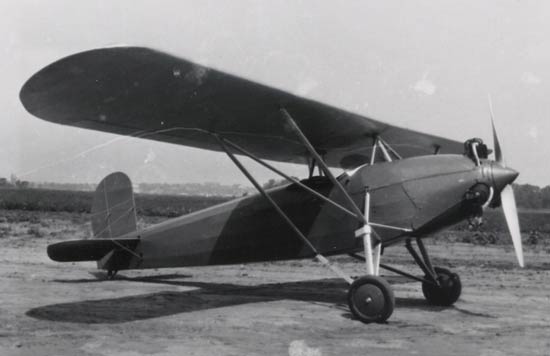 |
Below, from Mr. Borden, is a "...photo taken in September
1929 of my grandfather with the first production Inland Sport
model S-300 with the LeBlond 60 HP 5-cylinder engine." This
image is unretouched and shows some tearing or folding in the
lower and upper left corners.
L.D. Bonbrake With Sport S-300-E, 1929
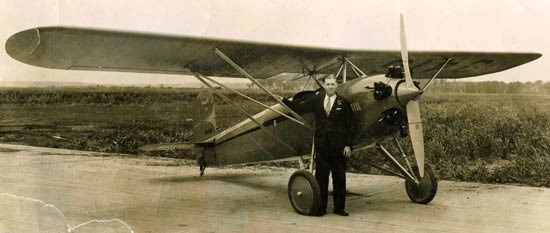 |
Propeller Detail

|
The registration number for
this airplane is 9416. It is not listed in the Davis-Monthan Register, but it does appear in the Parks Airport Register in 1929.
The original of the image above from Mr. Borden has wonderful
detail (compare with the image, left). Under magnification,
the name "Harttzell" can be read on the propeller
decal, and the manufacturer's logo and the registration number
are readable on the vertical stabilizer.
An image taken at the same location as above, but without
Mr. Bonbrake, is in Juptner, Volume 3, page 171 and duplicated
in Volume 4, page 143 (left sidebar). The Juptner image,
judging by the position of shadows on the ground, was also
taken at about the same time.
INLAND AIRCRAFT PLANT
Site visitor Bob Woodling shares the following three photographs with us. He says about the first one, "I found these Inland-related photos on the KC Public Library site [KCPL]. The Inland factory building at Fairfax airport is no longer standing, nor is the Fairfax airport operational, having been swallowed up by a massive GM automobile assembly plant."
Aerial View, Inland Aircraft Manufacturing Plant, Fairfax Airport, Ca. 1930 (Source: KCPL via Woodling)
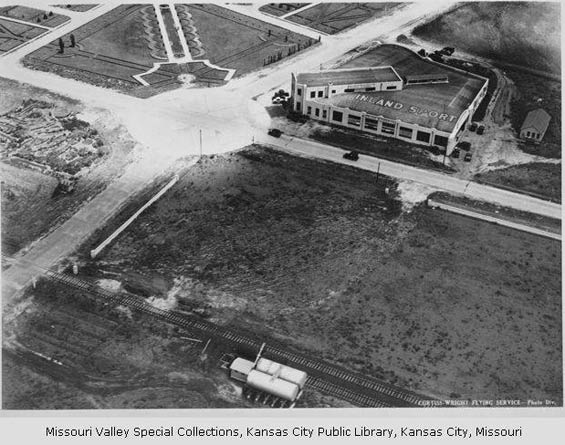 |
Mr. Woodling says about the next two photographs, "The two Inland airplane photos were taken at KC Municipal airport, just across the river from Fairfax. The airport terminal building in the background opened in 1928." The registration number on the tails of the first airplane is unreadable.
Unidentified Inland Aircraft, Kansas City Municipal Airport, 1929 (Source: KCPL via Woodling)
 |
Note the floodlight on the ground and the art deco accents on the window frames.
Unidentified Inland Aircraft, Kansas City Municipal Airport, 1929(Source: KCPL via Woodling)
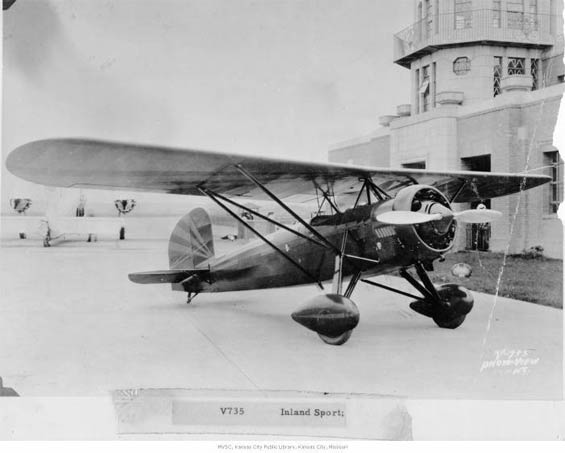 |
INLAND AIRCRAFT OF THE REGISTER
There are seven landings recorded in the Davis-Monthan
Register by six different Inland aircraft. The following
lists registration numbers, pilots and the dates, in order,
of their presence at the Airfield.
As stated above, Inland NX7255 landed September 5, 1928. This is the
prototype with the Anzani engine pictured above. The "Sport"
model, for which this was the prototype, was issued ATC #259
on October 19, 1929. It was flown by Tom [sic] "Gene" Gabbert
with passenger Arthur Hardgrave. Based in Kansas City, MO,
they were westbound from Lordsburg, NM to the la
Osa Guest Ranch about 65 miles from Tucson. If you follow
the link, you'll see the guest ranch began business in 1923
and is still in operation. Mr. Borden says of the visit,
"I found the logbook entry about Gene Gabbert and Art
Hardgrave stopping at D-M on their way to Los Angeles for
the 1928 National Air Races. Gene was a very close friend
of my grandfather, according to my mother. She told me that
Gene died in a plane crash sometime later [he did and the details are at his biography page linked above]."
And further, Mr. Borden says of Gabbart and Hardgrave,
"Arthur Hardgrave became the president of Inland Aviation
in Kansas City at Fairfax airport after flying to the Los
Angeles National Air Races in the Inland Sport prototype
with Gene Gabbert....
Arthur was impressed with the little Inland Sport and formed
Inland Aviation upon returning to Kansas City. Mr. Hardgrave
was a pilot too and won First Place in the 1930 National
Air Races, Sportsman Pilot Open Race, in an Inland Sport
model W-500 Super Sport [this was race event #41; the first
three places were swept by Inland Sports]. Originally from
Texas, Arthur Hardgrave was a venture capitalist and was
also president of the Kansas City Ice Company and president
of the Kansas City Chamber of Commerce. He later became a
board member of Helio Aircraft in Kansas."
A second Inland, W-500 Supersport NC8088, landed twice on
February 11, 1931 and April 21, 1931 flown by E.J. Williams.
Both times he carried passengers to and from Kansas City,
MO. Assigned ATC # 315, and manufactured during 1929, this
airplane still exists.
Likewise, a third Inland, NC509Y,
landed May 1, 1931 also flown by E.J. Williams. Williams
carried passenger Joe Shannon. Based in Kansas City, MO,
they were westbound to Los Angeles, CA. Mr. Borden says of
this airplane, "Inland
NC509Y is an Inland model S-400 Sportster which was the prototype
for the W-500 Supersport. This airplane had a 110 HP Warner
Scarab engine. The S-400 was certified under FAA ATC-343.
It was produced in 1930."
1929 Inland Sport model W-500 Super Sport NC252N was
the fourth to land on August 24, 1931. Follow the link to
see images of this airplane. It was flown solo by Martie
Bowman. She was westbound from Phoenix, AZ to Cleveland,
OH (see below). This airplane is presently owned by Mr. Borden.
He says about NC252N, "My
Inland Sport W-500 Super Sport has a Warner Scarab 125 HP
7-cylinder radial engine and an 88" Hamilton
Standard metal propeller. Inland made three models: the S-300'Sport'
which had a 60 HP 5-cylinder LeBlond engine, the R-400 'Sportster'
which had a Warner Scarab Jr. 85 HP 5-cylinder radial engine,
and the W-500 'Super Sport' which had a Warner Scarab
110 HP 7-cylinder radial engine. There are currently only
six Inland Sports registered with the FAA. Of these six airplanes,
there is one S-300, one R-400 and four W-500s. The W-500
established altitude and speed records in 1929 and 1930.
Inland Sports won several places at the 1930 National Air
Races. When Martie Bowman landed at Davis Monthan in NC252N,
she was engaged in the 1931 National Air Races Transcontinental
Handicap Air Derby—Women's Division that took her
from Los Angeles to Cleveland, Ohio. She placed third in
this race which had ten finshers. NC252N was also flown by
May Haizlip, another early aviatrix. [perhaps it was the
one she flew to victory in the Women's 500 cu. in. race in
1930] "
The fifth Inland, NC12838, landed November 16, 1931 flown
solo by Suzanne Garvin.
The final and sixth Inland , NC295N, an R-400 Sportster,
landed June 21, 1934. It was flown solo by Suzanne (Garvin) Williams.
This airplane was manufactured during 1930 under ATC # 343
(granted July 23, 1930). It is fairly clear from comparing
handwriting in the Register (check Register pages 176
and 204) that Suzanne Garvin and Suzanne Williams are the
same person. It is not clear if she might have married E.J.
Williams, pilot of two other Inlands. Does anyone KNOW?
I am looking for information about Suzanne Garvin/Williams,
as well as about E.J. Williams. Please use the link to help
me out.
---o0o---
UPLOADED: 11/21/07 REVISED: 01/25/08, 12/02/08, 12/16/13
|








